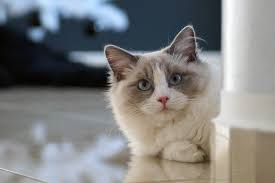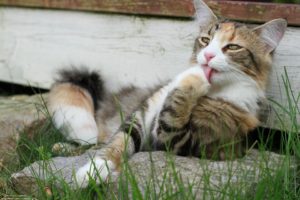Everything You Need to Know About Hairballs

Hacking, gagging, and then… there it is! A long-fought battle in your kitty’s esophagus is now on your living room floor. You break out the paper towels and some sort of cleaning product and go at it. As a cat mama myself, I know the struggles of cleaning up hairballs. After you watch in fear, feeling a little helpless as your cat hacks up some terrible fur-monster, you begin to think that there must be a way to prevent all the trauma (for kitty and you both). And, although you may not be able to prevent hairballs one-hundred percent of the time, you can always try to get your kitty’s hairball days down to a minimum. So, have no fear Feline Mama’s and Papa’s! Here is what I have learned from my years as a hairball-cleaning, cat-grooming, product-trying Cat Mama.
My cat Hank was really the first purr-baby that I knew that had a constant hairball problem. He hacks and struggles, and it would scare the living daylight out of me. Hank is a long-haired Maine coon mix. He is gorgeous, with a long bushy tail, a little bit of a beard, and belly fur that swishes on the floor like a broom. So, naturally I brush him twice a
week. Sometimes even more! But, Hank still somehow would have hairballs to cough up.
After buying different types of brushes and scouring the internet for ways to prevent hairballs and asking vets what to do, I finally found some answers!
1. Hairballs may be an underlying sign of food allergies.
This was not the case with Hank, but many cat’s may have problems digesting their food. And you may be asking yourself, how in the world does my cat’s food allergy factor into hairball production? The answer is simple: an upset stomach and grooming causes your kitty to ingest some of it’s fur. And along the way the food that is irritating your cat’s stomach then heaves up with the fur, looking more like a hairball and less like regular vomit.
2. Some cat breeds, Maine Coons included, are predisposed to other ailments that may help increase hairball production.
Some cat breeds, like Hank, have problems with the valves in their stomach and esophagus that causes excessive hairballs and hairball like symptoms. If you have a Maine Coon or Ragdoll cat, get them checked out by your vet.
3. Grooming your cat may not be enough.
Helping kitty by brushing his or her fur regularly may not be enough. Your cat may be a compulsive groomer. This means that your cat licks themselves so much that even keeping up with regular grooming they ingest extra fur.
4. There are food and treats that have hairball control in them.
Specially formulated food may contain ingredients that help control hairball production. Check with your vet before introducing these into your cat’s diet.
5. Vets may want to run lab tests to see what problems your kitty is experiencing.
Vets can run tests to see if your cat’s hairball problem is a chronic problem with an underlying cause or just an infrequent event caused by ingesting too much fur.
6. Change in diet may be required.
Sometimes a cat’s diet can irritate its digestive tract. Ask your vet about grain-free options.
7. Stay calm and don’t touch your cat.
Don’t bother the cat unless you are certain the cat’s airway is obstructed. If it is hacking and you can hear air coming out (i.e. your cat is making noise) you should not touch your cat. Just wait it out.
Here are the best ways to clean hairballs up depending on the surface:
1. Linoleum flooring is an easy clean.
First take a dry paper towel or baggie and pick the hairball up using it. Then throw that sucker away. I don’t recommend flushing! This will probably clog your pipes. Then take a damp paper towel and wipe up anything left over. Then I move to cleaning products. Whatever you clean your floors with usually will work.
2. Hardwood floors are medium difficulty.
This is because of all those darn joints in between the floorboards. Follow the instructions that are taken for linoleum flooring as far as picking up and cleaning up the residue. But the added steps are
- Being cautious of not grinding any of the hairball into the floor on accident and 2. If that does happen have an index card or cotton swab on hand. To get hairball residue out of floor joints, I recommend taking an index card, or a folded piece of paper and running it in-between the gaps. This way you lift it up and can wipe it away. If you are leery of that method, you can use a cotton swab and try the same thing.
3. Carpets are hard!
Any pet made mess is ten times harder to get out of a carpet. First, I would gently pick up the hairball and dispose of it just like we did in the last two tips. Then, what I do, is take my laundry detergent, a damp sponge, and some water and gently scrub at the spot. Then take an old dry rag of paper towel and put it over the spot and weigh it down with a shoe or old book. That way the excess water is sucked up and taken out of the fibers of your carpet. You can also use a rug scrubber or pet cleanup spray, but this is the easiest way to clean up if you don’t have those things on hand (and it smells great and is usually gentle on your carpet).
